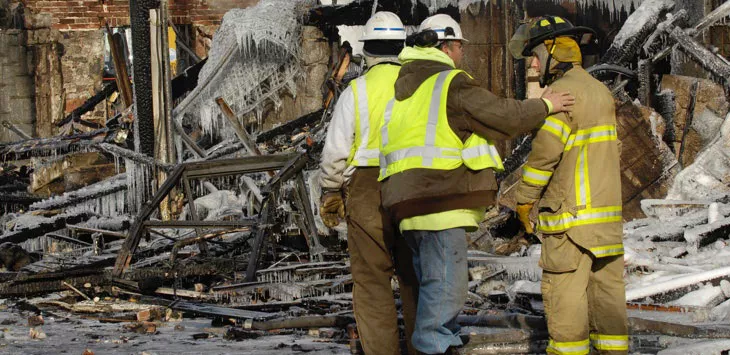Written by Michelle Whitmer | Edited By Walter Pacheco | Scientifically Reviewed By Arti Shukla, Ph.D.
Natural disasters such as wildfires, hurricanes, floods and tornadoes can damage asbestos-containing materials and lead to asbestos exposure among first responders, cleanup crews and nearby residents. Learn how to prevent asbestos exposure when preparing for and cleaning up after a natural disaster.
How Is Asbestos a Risk During a Natural Disaster?
A large number of homes and commercial buildings constructed prior to the 1980s were built with asbestos materials. Those products are considered safe as long as they are in good condition. But once ripped, broken, burned, blown or washed away, the products release toxic asbestos fibers into the air.
Breathing in these fibers in the aftermath of a natural disaster can lead to serious health conditions years later. The more someone is exposed to asbestos, the higher their risk of developing asbestos-related diseases such as a cancer called mesothelioma.
Natural disasters pose dangers from the moment they occur. People don’t often consider health risks after a tornado rips through their neighborhood or a flash flood destroys their personal possessions.
Asbestos exposure isn’t an immediate danger such as live electrical wires, gas leaks or unstable infrastructure. It also isn’t as apparent as more obvious health risks such as black mold. Asbestos fibers are microscopic and travel by air or in clouds of dust, so you can be exposed and not even know it.
It is essential to consider and properly prepare for asbestos exposure prevention when planning for natural disasters and severe weather. Knowing how to keep safe from asbestos after a disaster can help prevent health conditions later in life.
Who Is at Risk of Asbestos Exposure During a Disaster?
As the first people on the scene, emergency response crews and early response volunteers face an increased risk for asbestos exposure in the wake of a natural disaster because of all the debris. The risk of health effects increases over time and depends upon frequency and amount of exposure to asbestos to these workers.
Top First Responder Occupations at Risk
Firefighters
Law enforcement officials
Emergency response workers (FEMA, American Red Cross, etc.)
Enlisted military (Coast Guard, Navy, Army, etc.)
Cleanup crew members (private contractors, state and local agencies,volunteers)
Homeowners of damaged properties also face these risks and should alwaysuse caution when cleaning or searching through debris.
Products Containing Asbestos
There are dozens of asbestos-containing products in older construction such as single-family homes, apartment complexes, office buildings, churches and schools. These products are considered safe if they are in good condition and left undisturbed in walls, floors and the ceilings and roofs of structures.
But natural disasters pose a threat to these products which can be damaged by winds, fires, floods and earthquakes.
If asbestos-containing materials are suspected during cleanup efforts, experts recommend you leave them alone. Stirring up asbestos-containing debris can result in airborne asbestos fibers, and exposure is highly likely at that point.
Common Household Materials Containing Asbestos
Roofing felt
Pipe lagging
Block insulation
Adhesives
Appliance components
Ceiling products
Cement board
Gardening products
Flooring
Paints
Roofing
Table pads
Wallboard
Insulation
Fireplace decorations
Taping compounds and plasters
Electrical insulation and panels
Heating and cooling systems
Asbestos Exposure Prevention After a Disaster
Different types of natural disasters present a variety of asbestos exposure risks. For example, tornados may carry asbestos debris from one location to another, while floods may contaminate local waterways and neighborhoods with asbestos materials.
Fires present a greater risk to firefighters than other emergency responders. Hurricanes pose a variety of exposure threats from related tornados and flooding.
please visit https://www.asbestos.com/asbestos/natural-disasters/ for more information.



